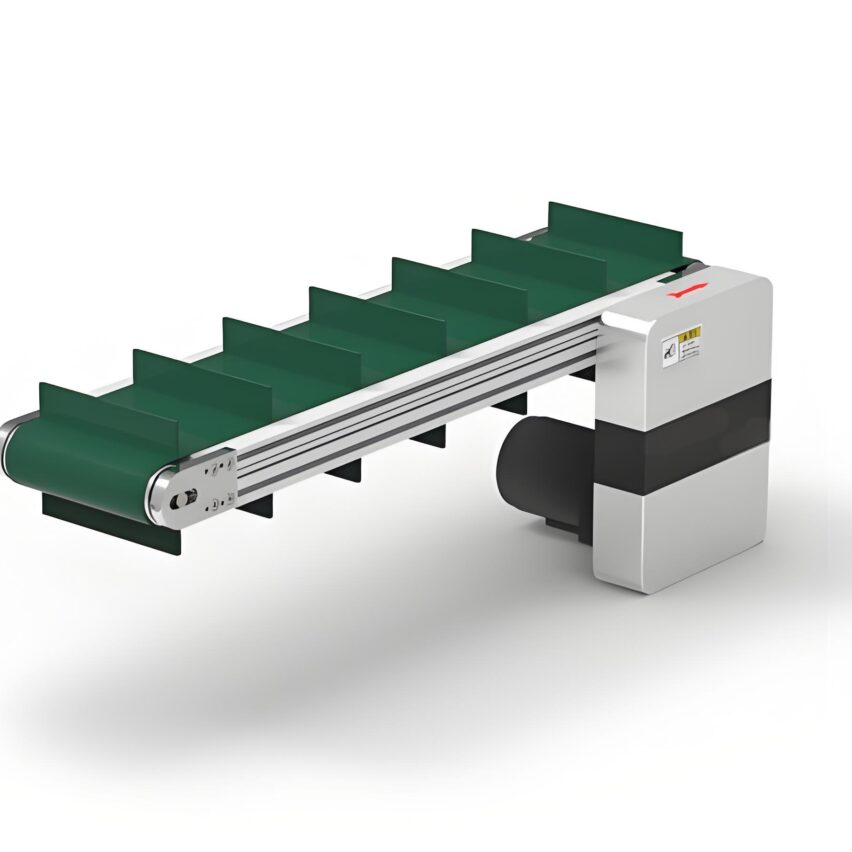Basic questions (what/why)
What is the core principle of the dual chain drive
The double chain drive uses two rows of parallel chains to synchronously pull the drums, and the torque distribution is achieved through the double sprocket mini-cycle drive. Compared with the single-chain macro-circulation, the double-chain structure spreads the power to two chains, which makes the force on each drum more balanced, and is especially suitable for long-distance conveying (>6 metres) and heavy-duty scenarios (up to 300kg/m load in a single line). Its core advantage is:
- Offset Load ResistanceIn single chain drive, the first drum is subjected to 70% power torque and the end is attenuated to 30%, while double chain drive reduces the torque difference to ±15%, avoiding sprocket wear and tooth skipping due to uneven stress on the drums.
- Curve Adaptability: The double sprocket wheels adopt staggered layout (sprocket pinch angle ≤5°), together with the conical roller (taper 3.6°), it can realise the curved conveyor with minimum turning radius R=300mm.
How low-maintenance design is achieved
Low maintenance design is centred on reducing the frequency of manual intervention and key components include:
- Lubrication-free bearing systems: Sealed deep groove ball bearings (IP54 protection class) with polyamide chain sprockets, reducing the coefficient of friction by means of self-lubricating materials, for 500 hours of maintenance-free operation.
- Quick release drum structure: The drum end caps are designed with snap-on connections, so that replacement can be done without disassembling the frame, and replacement of a single drum can be completed within 5 minutes (30 minutes for traditional threaded structures).
- Dust and Splash Proof End CapsPlastic end caps (made of polypropylene) prevent dust and liquid from intruding into the bearing cavity, extending bearing life by more than 3 times.
Scenario questions (how to do it/where to find it)
How to Configure Double Chaining Parameters for Heavy Load Scenarios
In heavy-duty scenarios (loads ≥ 1 tonne) such as automotive manufacturing and building materials handling, the following design specifications need to be followed:
- Chain SelectionPriority is given to 10A chain (pitch 15.875mm), single chain breaking strength ≥18kN, and the theoretical load is increased to 300kg/m after parallel connection of double chains.
- Calculation of roller centre distance: by the formulaT=n×p/2(n is integer, p is chain pitch) Determine the pitch. For example, the standard centre distance of 10A chain is 134.9mm and 150.8mm to avoid half-buckling the chain leading to derailment.
- Drive Redundancy Design: Install one set of driving motor (power ≥0.75kW) every 6 metres to prevent the chain from slipping due to tension slackness.
How to select materials for food-grade environments
At low temperatures (-25°C) or in corrosive environments (e.g. cold chain, chemical):
- Roller material: Stainless steel barrel (SUS304) with engineering plastic sprocket (polyamide) to avoid contamination by metal precipitation.
- Special treatment for bearings: -40℃ low-temperature resistant bearings filled with special grease to prevent brittle failure.
- Clean Design: Non-grooved drum surface (bare shaft construction) to avoid material residues that can harbour bacteria.
Solution (if not/what happens)
Troubleshooting of Dual Chain Asynchrony
When there is a speed deviation in the double chain drive, it needs to be troubleshooted:
- Tension failure: Loosening of the double chain independent tensioning mechanism leads to slackening of one side of the chain. Solution: Adopt spring automatic tensioner (stroke ≥50mm) to compensate the chain elongation in real time.
- Differences in sprocket wear: Excessive wear (>0.5mm) on one side of the sprocket tooth profile. Countermeasures: Check the diameter of sprocket pitch circle every 2000 hours and replace it in pairs if the deviation exceeds 0.2mm.
case (law)A logistics sorting centre failed to replace the sprockets synchronously, resulting in a 37% increase in the runout rate of the drum line, and the fault was zeroed after the replacement.
Bearing Failure Prevention Strategies
Bearing damage accounted for 68% of drum line failures, and the main causes included:
- Lubrication contamination: Traditional oil lubrication adsorbs dust to form abrasive paste. Improvement programme: Switch to solid grease (PTFE-based) or lubrication-free bearings.
- axial shock: Spalling of bearing raceways due to impact of falling material. Preventive design: Add polyurethane cushion ring (Shore hardness 90A) at the end of the drum to absorb the impact energy.
How Intelligent Maintenance Reduces Costs
Predictive maintenance through IoT technology:
- Vibration monitoring: Installation of acceleration sensors at the drive end to warn of bearing abnormalities when the vibration value is >4m/s² (normal value <2.5m/s²).
- Temperature closed loop control: Motorised pulley with built-in temperature probe, automatic speed reduction over 80°C to avoid high temperature sintering of bearings.
Data validationAfter the introduction of the intelligent system in an automotive plant, maintenance costs were reduced by 421 TP3T and downtime by 761 TP3T.
reach a verdictThe dual-chain drive improves system reliability through power dispersion, while the low-maintenance design starts with material innovation (lubrication-free bearings) and structural optimisation (quick-release rollers), which combine to reduce the overall failure rate of the roller line by 60%. The future direction is to incorporate IIoT technology to realise a "zero-unplanned-downtime" intelligent conveyor system. The future direction is to integrate IIoT technology to achieve "zero unplanned downtime" intelligent conveyor system.













